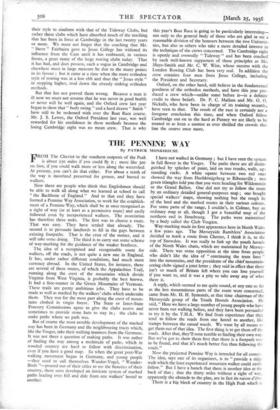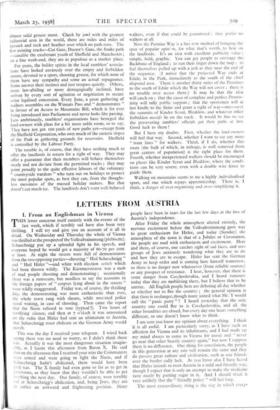THE PENNINE WAY
By PATRICK MONKHOUSE
FROM The Cheviot to the southern outposts of the Peak is about 25o miles if you could fly it ; more like 300 on foot, if you could walk more or less along the watershed. At present, you can't do that either. For about a tenth of the way is moorland preserved for grouse, and barred to walkers.
Now there are people who think that Englishmen should be able to walk all along what we learned at school to call " the Backbone of England." And to that end they have formed a Pennine Way Association, to work for the establish- ment of a Pennine Way, which shall be at once recognised as a right of way (or at least as a permissive route) and easily followed even by inexperienced walkers. The association has therefore three tasks. The first was to choose a route. That was easy. They have settled that already. The second is to persuade landlords to fill in the gaps between existing footpaths. That is the crux of the matter, and it will take some doing. The third is to carry out some scheme of way-marking for the guidance of the weaker brethren.
The idea of a recognised and recognisable route for walkers, off the roads, is not quite a new one in England. It has, under rather different conditions, had much more currency abroad. In the United States, for instance, there are several of these routes, of which the Appalachian Trail, running along the crest of the mountains which divide Virginia from West Virginia, is probably the best known. It had a fore-runner in the Green Mountains of Vermont. These trails are pretty ambitious jobs. They have to be made as well as marked by the walkers' clubs which undertake them. They run for the most part along the crest of moun- tains clothed in virgin forest. The State or Inter-State Forestry Commissions agree to give the clubs access and sometimes to provide stone huts to stay in ; the clubs to make paths where no path was.
But of course the most notable development of the marked way has been in Germany and the neighbouring tracts which, like the Vosges, take their walking manners from the Germans. It was not there a question of making paths. It was rather of finding the way among a multitude of paths, which in wooded country are hard to follow with discrimination, even if you have a good map. So when the great post-War walking movement began in Germany, and young people —they used to call themselves Wander-Vogel, " Wander- Birds "—poured out of their cities to see the beauties of their country, there soon developed an intricate system of marked paths leading over hill and dale from one walkers' hostel to another. I have not walked in Germany ; but I have seen the system in full flower in the Vosges. The paths there are all distin- guished by splashes of paint, laid on tree trunks, walls, up- standing rocks. A white square between two red ones showed the way from Hochkonigsberg to Ribeauville ; two green triangles told you that you were heading for Wildenstein or the Grand Ballon. One did not try to follow the route by an ordinary detailed general-purposes map ; one bought special walkers' maps, showing nothing but the rough lie of the land and the marked routes in their various colours. For some parts of the range, I couldn't, in Colmar, buy an ordinary map at all, though I got a beautiful map of the northern end in Strasbourg. The paths were maintained by a body called the Club Vosgien.
Way-marking made its first appearance here in North Wales a few years ago. The Merseyside Ramblers' Association decided to mark a route from Chester, I think it is, to the top of Snowdon. It was really to link up the youth hostels of the North Wales chain, which are maintained by Mersey- side. There was some opposition at the time from people who didn't like the idea of " continuing the tram lines " into the mountains, and the presidents of the chief mountain- eering clubs signed a joint letter ; they said in effect that there isn't so much of Britain left where you can lose yourself if you want to, and it was a pity to take away any of what there is.
A reply, which seemed to me quite sound, at any rate so far as the less mountainous parts of the route were concerned, came from Mr. H. H. Symonds, at that time chairman of the Merseyside group of the Youth Hostels Association. He said, " Here we have a large number of young people who have never been out walking before, and they have been persuaded to try it by the Y.H.A. We find from experience that they tend to follow the roads from one hostel to another, like tramps between the casual wards. We want by all means to get them out of that idea. The first thing is to get them off the roads. After that, they'll soon tumble to finding their own way. But we've got to show them first that there is a footpath way to be found, and that it's much better fun than following the roads."
Now the projected Pennine Way is intended for all corners. The idea, says one of its organisers, is to " provide a ridge walk which the least experienced mountain walker could easily follow." But I have a hunch that there is another idea at the back of that ; that the thirty miles without a right of way, apparently the obstacle to the plan, are in fact its raison d'être.
There is a big block of country in the High Peak which is almost solid grouse moor. Cheek by jowl with the greatest industrial area in the world, there are miles and miles of tussock and rock and heather over which no path runs. The few existing tracks—Cut Gate, Doctor's Gate, the Snake path —canalise the exuberant youth of Sheffield and Manchester; on a fine week-end, they are as populous as a market place.
For years, the bolder spirits in the local ramblers' associa- tions have looked enviously over the empty and forbidden moors, devoted to a sport, shooting grouse, for which none of them have any sympathy and some an actual repugnance. Some answer their instinct and just trespass quietly. Others, more law-abiding or more demagogically inclined, have striven by every sort of agitation or negotiation to secure some legalised concession. Every June, a great gathering of walkers assembles on the Winnats Pass and " demonstrates " in favour of an Access to Mountains Bill, which is for ever being introduced into Parliament and never looks like passing. Less ambitiously, ramblers' organisations have besieged the land-owners with pleas for a bit more ankle room, so to say. They have not got too yards of new paths yet—except from the Sheffield Corporation, who own much of the eastern slopes of the Peak as gathering grounds for reservoirs. Sheffield is controlled by the Labour Party.
The trouble is, of course, that they have nothing much to offer the landlords in return for a right of way. They may offer a guarantee that their members will behave theinselves nicely and not deviate from the permitted tracks ; they may point proudly to the quite effective labours of the voluntary " countryside wardens " who turn out on holidays to protect the most popular spots, as best they can, from the thought- less messiness of the massed holiday makers. But that doesn't cut much ice. The landlords don't want well-behaved walkers, even if that could be guaranteed ; they prefer no walkers at all.
Now the Pennine Way is a fine new method of bringing the spur of popular opini 3n, for what that's worth, to bear on the landlords. It's an idea with excellent publicity value ; simple, bold, graphic. You can get people to envisage the Backbone of England ; to run their finger down the map ; to feel themselves pulled up with a jerk as they near the end of the sequence. (I notice that the projected Way ends at Edald, in the Peak, immediately to the south of the chief disputed area. There is another thirty miles of the Pennines to the south of Edale which the Way will not cover ; there is no trouble over access there.) It may be that the idea will catch on ; that the cause of complete and perfect Pennin- inity will rally public support ; that the sportsmen will at last kindle to the flame and grant a right of way—one--over the summits of Kinder Scout, Bleaklow, and whatever other forbidden massifs lie on the track. It would be fine to see the persevering ramblers' officials get their paths at last. Good luck to them !
But I have my doubts. First, whether the land-owners will feel that way. Second, whether I want to see any more " tram lines " for walkers. Third, if I do, whether this route (the bulk of which, in mileage, is well removed from great centres of population) is the right place for them. Fourth, whether inexperienced walkers should be encouraged on places like Kinder Scout and Bleaklow, where the condi- tions can be very severe, even with a double wire fence to guide them.
Walking on mountains seems to me a highly individualised sport, and one which repays apprenticeship. There is, I think, a danger of over-organising and over-simplifying it.











































































 Previous page
Previous page